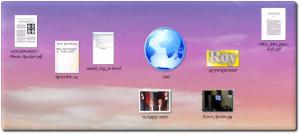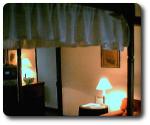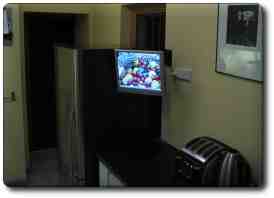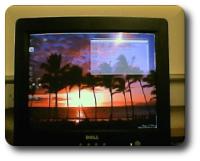
PDF‘s, text files, HTML‘s and
directories in the KDE Desktop with previews (click to enlarge)
 ver had the experience of staring at a collection of files, wondering which one is which and puzzled by the best way of finding the text or images you are after? This was a wide-spread operating system deficiency in the nineties (there was a brute-force barrier). Nowadays, directories reflect on their content and file previews are generated on-the-fly, even over FTP, i.e. remote data.
ver had the experience of staring at a collection of files, wondering which one is which and puzzled by the best way of finding the text or images you are after? This was a wide-spread operating system deficiency in the nineties (there was a brute-force barrier). Nowadays, directories reflect on their content and file previews are generated on-the-fly, even over FTP, i.e. remote data.
With a large enough icon size as shown above (an example from KDE), even entire documents reflect on their content. Similar types of previews exist for animations and — oddly enough — sound.
By obtaining this reflection on content, there is no longer a need to open files in vain. Location of content becomes an easier task as it can be done visually rather than relying on filenames. Files are simply more recognisable since they express their purpose in the most natural way. If a pictures is worth a thousands words, the user is able to scan more data, more quickly.
Preview are not the only way of improving productivity. Work is being done on extending the “drag-and-drop” functionality for items, e.g. animated folding and dropping (videos included) and richer desktop interactions. As a matter of preference, I like keeping my Desktop clean, making it a ‘yet-to-complete’ list. Previews on files cannot resolve the issue of clutter and scale; they can, however, compensate for the expressiveness of filenames.
For those who do not know yet, Windows Longhorn was intended to introduce WinFS. This new filesystem, rather than using filetables (notably FAT32), was aimed at getting rid of traditional file management and filenames altogether. Nevetheless, Longhorn ended up incorporating none of the promised innovative features though.
 n a matter of hours I will head off to a plenary research meeting at Oxford University. I decided to catch the 5 AM train rather than arriving at Oxford yesterday. It has become rather difficult to stay off-line for more than half a day, let alone a day or two. Many hundreds of messages accumulate in the newsgroups, many dozens in mailing lists, and about 100 RSS feeds need catching up with. Moreover, error logs expire, server have potential of crashing, and physically speaking, no proper exercise can be undertaken.
n a matter of hours I will head off to a plenary research meeting at Oxford University. I decided to catch the 5 AM train rather than arriving at Oxford yesterday. It has become rather difficult to stay off-line for more than half a day, let alone a day or two. Many hundreds of messages accumulate in the newsgroups, many dozens in mailing lists, and about 100 RSS feeds need catching up with. Moreover, error logs expire, server have potential of crashing, and physically speaking, no proper exercise can be undertaken.







 Filed under:
Filed under: 
 Google have introduced yet another ‘toy’ which re-uses the software from
Google have introduced yet another ‘toy’ which re-uses the software from 

 ver had the experience of staring at a collection of files, wondering which one is which and puzzled by the best way of finding the text or images you are after? This was a wide-spread operating system deficiency in the nineties (there was a brute-force barrier). Nowadays, directories reflect on their content and file previews are generated on-the-fly, even over FTP, i.e. remote data.
ver had the experience of staring at a collection of files, wondering which one is which and puzzled by the best way of finding the text or images you are after? This was a wide-spread operating system deficiency in the nineties (there was a brute-force barrier). Nowadays, directories reflect on their content and file previews are generated on-the-fly, even over FTP, i.e. remote data.
 In practical terms, anti virus software for Palm handhelds is utterly unnecessary. There are two known Palm viruses, which are “proof of concept”; nothing has been shown to be malicious beyond this fabricated illusion. Such viruses are created by anti-virus developers and vendors in order to create a scare and prove that Palm handhelds are potentially penetrable. The viruses have not been found “in the wild” yet and this state is unlikely to change any time soon. Remember that Palm handhelds have remote access capabilities (SSH, telnet, VNC etc.) but do not yet allow access and control from the outside. It is simply not practical because they are mobile — it is their nature to be the controlling device (master), not the controlled device (slave). You can use your remote control to affect your TV, but not the TV to affect your remote control.
In practical terms, anti virus software for Palm handhelds is utterly unnecessary. There are two known Palm viruses, which are “proof of concept”; nothing has been shown to be malicious beyond this fabricated illusion. Such viruses are created by anti-virus developers and vendors in order to create a scare and prove that Palm handhelds are potentially penetrable. The viruses have not been found “in the wild” yet and this state is unlikely to change any time soon. Remember that Palm handhelds have remote access capabilities (SSH, telnet, VNC etc.) but do not yet allow access and control from the outside. It is simply not practical because they are mobile — it is their nature to be the controlling device (master), not the controlled device (slave). You can use your remote control to affect your TV, but not the TV to affect your remote control.
 buntu is a Linux distribution that is based on Debian and resembles it too. This Gnome-based (also see
buntu is a Linux distribution that is based on Debian and resembles it too. This Gnome-based (also see